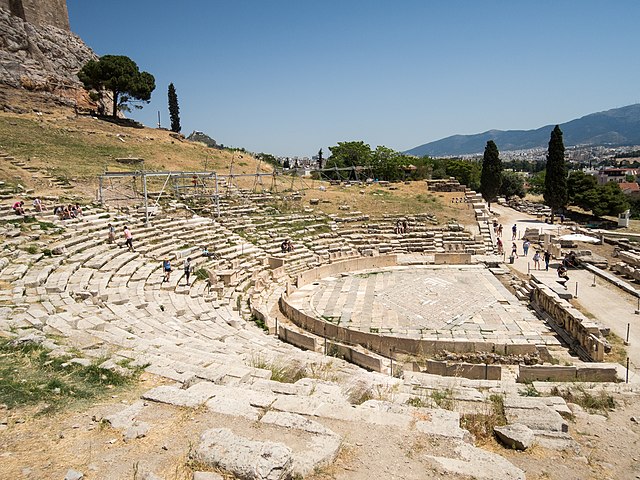The Theatre of Dionysus is an ancient Greek theatre in Athens. It is built on the south slope of the Acropolis hill, originally part of the sanctuary of Dionysus Eleuthereus. The first orchestra terrace was constructed on the site around the mid- to late-sixth century BC, where it hosted the City Dionysia. The theatre reached its fullest extent in the fourth century BC under the epistates of Lycurgus when it would have had a capacity of up to 25,000, and was in continuous use down to the Roman period. The theatre then fell into decay in the Byzantine era and was not identified, excavated and restored to its current condition until the nineteenth century.
View of the Theatre and Sanctuary of Dionysus from the west
Apulian volute-krater, close to the Sisyphus Painter, c. 400 BC. Possibly related to Euripides’ lost play Andromeda, and is suggestive of the kind of stage props that might have been used.
Prohedria from the Lycurgan theatre.
Fiechter's reconstruction of the Lycurgan theatre. View from the north.
Theatre of ancient Greece
A theatrical culture flourished in ancient Greece from 700 BC. At its centre was the city-state of Athens, which became a significant cultural, political, and religious place during this period, and the theatre was institutionalised there as part of a festival called the Dionysia, which honoured the god Dionysus. Tragedy, comedy, and the satyr play were the three dramatic genres emerged there. Athens exported the festival to its numerous colonies. Modern Western theatre comes, in large measure, from the theatre of ancient Greece, from which it borrows technical terminology, classification into genres, and many of its themes, stock characters, and plot elements.
Bronze statue of a Greek actor, 150–100 BC. The half-mask over the eyes and nose identifies the figure as an actor. He wears a man's conical cap but female garments, following the Greek custom of men playing the roles of women. Later, slave women were brought in to play minor female characters and in comedy as well.
View of the ancient theatre at Epidaurus, considered by Pausanias the finest in Greece.
The Theatre of Dionysus
Roman, Republican or Early Imperial Relief of a seated poet (Menander) with masks of New Comedy, 1st century BC. – early 1st century AD, Princeton University Art Museum







